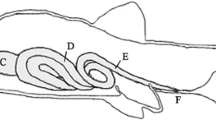Abstract
Polyphenols were located in all the layers of the periostracum and in inclusion bodies in the inner face of the outer-fold cells of Mytilus edulis L. Results, after 4 days periostracum repair, show that the proto-ostracal material is deposited in distinct layers. Inclusion bodies in the cells of the inner face of the outer fold appear to give rise to the polyphenols in the proto-ostracal material.
Similar content being viewed by others
Literature Cited
Beedham, G. E.: Observations on the non-calcarous component of the shell of the Lamellibranchia. Q. Jl microsc. Sci. 99, 341–357 (1958a).
—: Observations on the mantle of the Lamellibranchia. Q. Jl microsc. Sci. 99, 181–197 (1958b).
— and G. Owen: The mantle and shell of Solemya parkinsonii (Protobranchia:Bivalvia). Proc. zool. Soc. Lond. 144, 405–430 (1965).
Brown, C. H.: Some structural proteins of Mytilus edulis. Q. Jl microsc. Sci. 93, 487–502 (1952).
Brunet, P. C. J.: Sclerotins. Endeavour 26, 68–75 (1967).
Bubel, A.: An electron-microscope study of periostracum formation in some marine bivalves 1. The origin of the periostracum. Mar. Biol. 20, 213–221 (1973a).
—: An electron-microscope study of periostracum formation in some marine bivalves. II. The cells lining the periostracal groove. Mar. Biol. 20, 222–234 (1973b).
—: An electron-microscope study of periostracum repair in Mytilus edulis. Mar. Biol. 20, 235–244 (1973c).
Hillman, R. E.: Formation of the periostracum in Mercenaria mercenaria. Science, N.Y. 134, 1754–1755 (1961).
Knight, P. D.: Sclerotization of the perisarc of the calytoblastic hydroid, Laomedea flexuosa. 2. Histochemical demonstration of phenol oxidase and attempted demonstration of peroxidase. Tissue Cell 3, 57–64 (1971).
Lison, L.: Histochimie et cytochimie animales, pp 422–425. Paris: Gauthier-Villars 1955.
Locke, M. and N. Krishnan: The distribution of phenoloxidases and polyphenols during cuticle formation. Tissue Cell 3, 103–126 (1971).
Meenakshi, V. R., P. E. Hare, N. Watabe and K. M. Wilbur: The chemical composition of the periostracum of the molluscan shell. Comp. Biochem. Physiol. 29, 611–620 (1969).
Minganti, A. and R. Mancuso: Tyrosinase activity in embryos of Physa fontinalis. Acta Embryol. Morph. exp. 5, 199–205 (1962).
Rambourg, A., W. Hernandez and C. P. LeBlond: Detection of complex carbohydrates in the Golgi complex of rat cells. J. Cell Biol. 40, 395–414 (1969).
Timmermans, L. P. M.: Studies on the shell formation in molluscs. Neth. J. Zool. 19, 417–523 (1969).
Author information
Authors and Affiliations
Additional information
Communicated by J. H. S. Blaxter, Oban
Rights and permissions
About this article
Cite this article
Bubel, A. An electron-microscope investigation into the distribution of polyphenols in the periostracum and cells of the inner face of the outer fold of Mytilus edulis . Mar. Biol. 23, 3–10 (1973). https://doi.org/10.1007/BF00394106
Accepted:
Issue Date:
DOI: https://doi.org/10.1007/BF00394106




